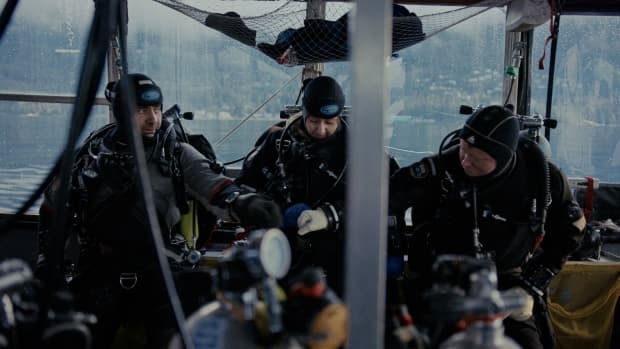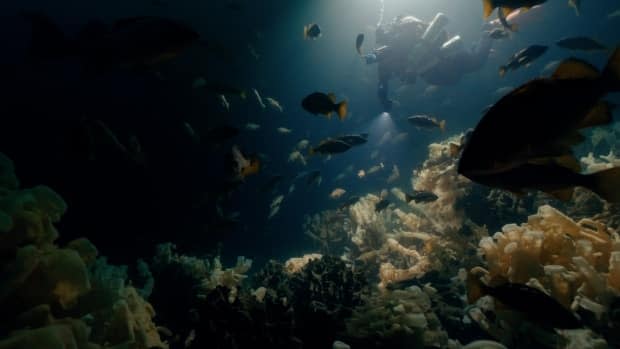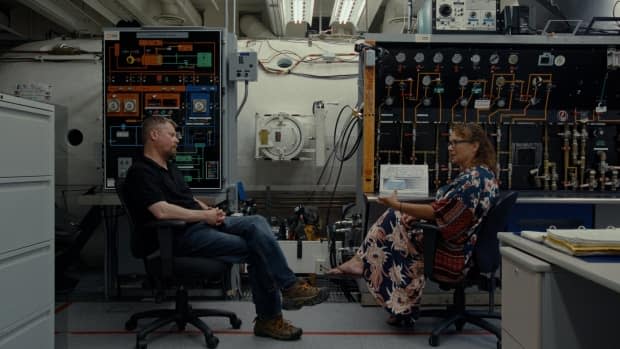'Otherworldly' glass sponge reefs off B.C. featured in new documentary
It takes an experienced deep-water diver like Hamish Tweed to reach most of the glass sponge reefs.
You have to descend more than 60 metres into the depths of B.C.'s Howe Sound where, even in the middle of the day, you're sinking into total darkness.
Tweed has seen plenty of glass sponges in his years diving off of the province's South Coast, but those were individual animals; the enormous reefs are different. He still remembers the date of his first visit to one of them: Feb. 23, 2013, a Saturday.
When the diver's underwater light hits the magnificent, alien reef, its scale comes into focus.
"It's the sheer size of the bioherm, or the reef itself, that I think is the biggest shocker for me," said Tweed. "It's more like rolling hills of sponge. And so that, just in itself, is overwhelming."
The reefs were common during the Cretaceous period, more than 65 million years ago, but they were thought to be extinct until discoveries were made off the B.C. coast in recent decades. Now, Howe Sound, just northeast of Vancouver, is recognized as a unique place where the reefs have thrived.

They're referred to as bioherms, built-up mounds created over thousands of years as glass sponges die off, their bodies hardening into the structure of the reef. More glass sponges grow on top of the heap. The bioherms provide small spaces in which other creatures can live, leading to extraordinarily rich ecosystems.
But the reefs are delicate, and at risk of damage by humans through fishing activity, anchoring, and climate change.
Tweed, along with others involved in the search for the reefs and the campaign to protect them, are featured in a new documentary, Moonless Oasis.
Watch Moonless Oasis on CBC Gem:
The group has been very successful — not only in locating the reefs (an effort led by Glen Dennison using a drop camera from the surface) — but also in urging officials to protect them.
Last year many of the sites were protected from bottom-contact fishing by the federal government.
Ten of the 17 known glass sponge reefs in Howe Sound are protected as refuges, according to Jessica Schultz, a marine ecologist who was recently part of Ocean Wise's Howe Sound research and conservation team.
"Those refuges were an important step toward recognizing the ecological importance and the uniqueness of these reefs, and the next step in conservation is to make sure there's monitoring and enforcement," said Schultz.
"It wasn't a group of politicians and scientists that really did the heavy lifting on the conservation — it was community members and individuals dedicating their own time," she said.

Schultz said the reefs are an example of the wonders that are still awaiting discovery and appreciation under water, where it's estimated 90 per cent of species on the sea floor still haven't been identified.
But she warns that globally, the ocean's diversity is being lost.
"We know that more diverse ecosystems are good for human health and prosperity and livelihoods, so it's not an exaggeration to say that every species counts," said Schultz.
Highlighting that effort to protect not just the fragile glass sponge reefs, but also the natural environment in general, is what inspired Moonless Oasis director Nate Slaco to undertake the film.
He said you don't have to be a technical diver like Tweed to make a difference; in fact, he stayed above the surface throughout the project.

"There's something in your backyard that I'm sure is worth protecting and there are things you can do about it," said Slaco.
But beyond the message of conservation, he said the strange and wondrous glass sponge reefs drew him in.
"It just looks like something from a different planet," said Slaco. "It just looks otherworldly."


